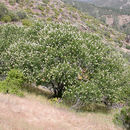California buckeye grows on dry slopes, in canyons, and along waterways
[
5,
21]. In the Central Valley it occurs along stream and river banks
[
5,
19]. It is associated with poison-oak (Toxicodendron diversilobum)
in most communities in which it occurs [
5,
17].
Soil: California buckeye grows in sandy, sandy-loam, or gravelly-loam
soils [
5].
Climate: California buckeye occurs in a Mediterranean climate with cool
moist winters and hot dry summers [
5,
15,
18]. The mean annual rainfall
is less than 14 inches, and temperatures are in excess of 100 degrees
Fahrenheit (38 degrees C) for several successive days every summer [
14].
Elevation: California buckeye occurs below 4,000 feet (1,219 m) [
21].

